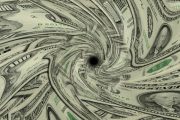
Imagine walking into your local bank to open a savings account. After the chitchat period is over and the setup process begins, you remember to ask what the interest rate will be on your new account. “Zero point five percent,” says the new accounts representative. Upon shaking your head and grumbling about how little you’ll be getting, she looks at you and says with a smile, “You don’t understand. You pay us.”
Although that isn’t happening to consumers (yet), central banks around the world — trapped in near-zero growth and at serious risk of price deflation — have driven interest rates so far down that a number of countries have intentionally resorted to negative interest rates in an attempt to stimulate lending.
What are negative interest rates, and how do they affect the world economy? Let’s start by examining how banks obtain the liquidity they need to lend money.
Bank Liquidity and Lending
Most banks earn the majority of their income by making loans. Depositor funds, the Federal Reserve, and a variety of agency credit lines are tapped to lend out to individuals, businesses, and other borrowers. The spread between what the bank must pay for the money (cost of funds) and what it earns on loans is called the net interest margin, which should be sufficient to cover overhead, operating expenses, and a reserve for future loan losses. Anything left over is profit.
A humorous summation of banking is the “3-6-3” rule, which Investopedia.com spells out as follows:
The 3-6-3 rule describes how bankers would give 3% interest on depositors’ accounts, lend the depositors money at 6% interest and then be playing golf at 3 pm. This alludes to how a bank’s only form of business is lending out money at a higher rate than what it is paying out to its depositors.
A bank’s business model usually requires that lending be active in order to earn a reasonable profit. When loans are in high demand, a bank has a greater need for deposits, federal funds, and/or lines of credit as sources of liquidity to fuel lending activities. If lending drops, the bank sends excess funds to the central bank on a short-term basis, earning a small return on its investment.
Monetary Policy as a Tool to Stimulate the Economy
The Federal Reserve has become addicted to aggressive monetary policy over the past few decades. Its drastic measures immediately before, during, and after the the Great Recession were unprecedented in terms of size, scope, and duration.
Under the theory that lowering interest rates would stimulate bank lending while creating a disincentive to sit on cash, the Federal Reserve drove interest rates to record low levels. Three-month Treasury bills dropped from 5.03 percent in February 2007 to just 0.30 percent two years later. Rates remained near rock-bottom for almost seven years before the Fed began to slowly unwind the stimulus, raising a key index by 0.25 percent last December. More increases are anticipated over time in order to normalize the yield curve.
Negative Interest Rates
What if lowering interest rates to zero fails to produce the desired results? The unthinkable is now happening in several countries around the world: negative interest rates.
Per Investopedia.com, the definition of negative interest rates is as follows:
A negative interest rate policy (NIRP) is an unconventional monetary policy tool whereby nominal target interest rates are set with a negative value, below the theoretical lower bound of zero percent.
With negative interest rates, if a bank has liquidity greater than loan demand and wishes to park it in a central bank on a short-term basis, they no longer earn a return on the investment. They pay for the privilege.
Europe Has Recently Seen Negative Interest Rates
As disastrous as the U.S. economy has been over the past 10 years, Europe is in even worse shape, suffering a recession in 2012-13 and experiencing economic growth of only about one percent over the same period of time.
Much like the Federal Reserve, European central banks lowered interest rates over the past decade, hoping increased bank lending would spur growth. When rates hit zero, a number of countries didn’t stop there. The European Central Bank, the Danish National Bank, the Swedish Riksbank, and the Swiss National Bank dropped rates into the negative, with Austria, Denmark, Germany, the Netherlands, and Switzerland joining the fray on selective short-term bonds. Recently, Japan’s central bank lowered its overnight rate to -0.10 percent.
Could It Happen in the United States?
Although the Federal Reserve has begun raising rates, there is a reasonable chance that economic growth will grind to a halt within the next couple of years, possibly tipping the United States into a recession. Unlike during the Great Recession, there would be very little room for the Fed to maneuver, as interest rates would not have had sufficient time to fully normalize.
Unless, of course, the Fed allows rates to fall into the negative.
That’s the premise the Fed has informed a number of larger banks they will be stress-testing for, including a scenario where three-month Treasury bills stay negative for almost three years. “The severely adverse scenario is characterized by a severe global recession, accompanied by a period of heightened corporate financial stress and negative yields for short-term U.S. Treasury securities,” the central bank said in announcing the stress tests last week.
Officials have indicated a willingness to consider negative interest rates if economic circumstances warrant such a drastic action.
Central Bank Madness
Although there hasn’t yet been a doomsday scenario triggered by European negative interest rates, the rates are nevertheless an indication of out-of-control governmental interference. Despite Vermont Senator Bernie Sanders’ campaign trail adulation of northern Europe, it is far from an economic Nirvana. In fact, with its slower growth, lower productivity, and substantially higher taxes, it is closer to an object lesson of what not to do.
Adding trillions to both the national debt and the money supply for Band-Aid solutions to structural economic problems is bad enough, but the Fed’s willingness to consider pushing rates into the negative is akin to monetary madness. Despite massive doses of governmental intervention, slow growth throughout the Western world over the past decade brings to mind the Milton Friedman quote, “Nothing is so permanent as a temporary government program.”



